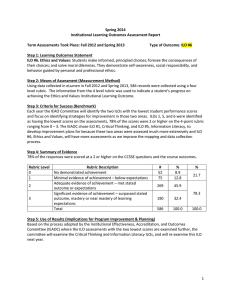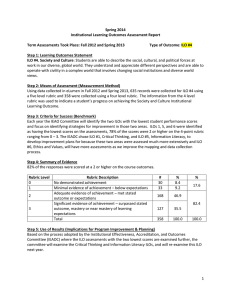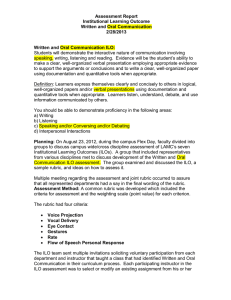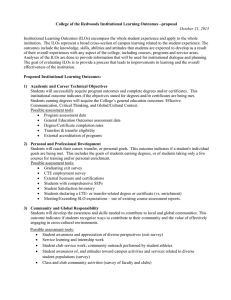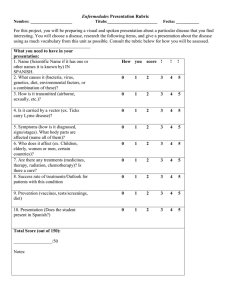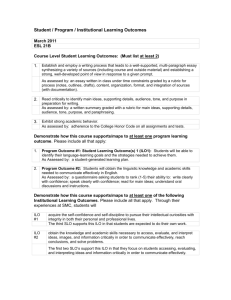Spring 2014 Institutional Learning Outcomes Assessment Report
advertisement
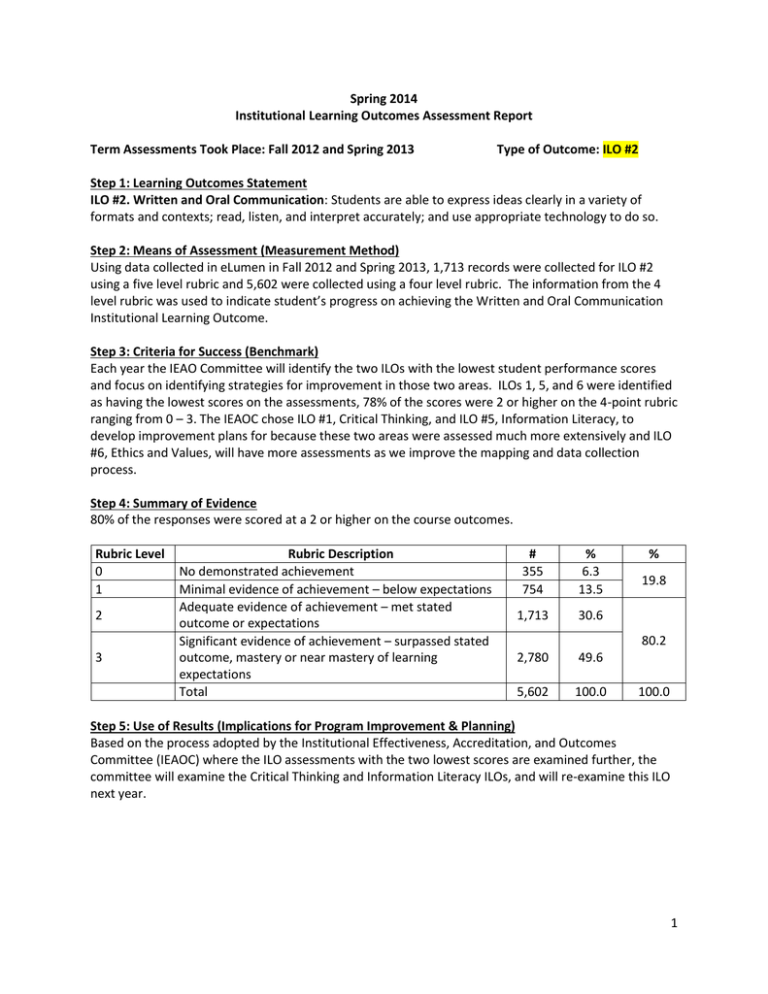
Spring 2014 Institutional Learning Outcomes Assessment Report Term Assessments Took Place: Fall 2012 and Spring 2013 Type of Outcome: ILO #2 Step 1: Learning Outcomes Statement ILO #2. Written and Oral Communication: Students are able to express ideas clearly in a variety of formats and contexts; read, listen, and interpret accurately; and use appropriate technology to do so. Step 2: Means of Assessment (Measurement Method) Using data collected in eLumen in Fall 2012 and Spring 2013, 1,713 records were collected for ILO #2 using a five level rubric and 5,602 were collected using a four level rubric. The information from the 4 level rubric was used to indicate student’s progress on achieving the Written and Oral Communication Institutional Learning Outcome. Step 3: Criteria for Success (Benchmark) Each year the IEAO Committee will identify the two ILOs with the lowest student performance scores and focus on identifying strategies for improvement in those two areas. ILOs 1, 5, and 6 were identified as having the lowest scores on the assessments, 78% of the scores were 2 or higher on the 4-point rubric ranging from 0 – 3. The IEAOC chose ILO #1, Critical Thinking, and ILO #5, Information Literacy, to develop improvement plans for because these two areas were assessed much more extensively and ILO #6, Ethics and Values, will have more assessments as we improve the mapping and data collection process. Step 4: Summary of Evidence 80% of the responses were scored at a 2 or higher on the course outcomes. Rubric Level 0 1 2 3 Rubric Description No demonstrated achievement Minimal evidence of achievement – below expectations Adequate evidence of achievement – met stated outcome or expectations Significant evidence of achievement – surpassed stated outcome, mastery or near mastery of learning expectations Total # 355 754 % 6.3 13.5 1,713 30.6 2,780 49.6 5,602 100.0 % 19.8 80.2 100.0 Step 5: Use of Results (Implications for Program Improvement & Planning) Based on the process adopted by the Institutional Effectiveness, Accreditation, and Outcomes Committee (IEAOC) where the ILO assessments with the two lowest scores are examined further, the committee will examine the Critical Thinking and Information Literacy ILOs, and will re-examine this ILO next year. 1 Table 1: Spring 2013 Student ratings on the CCSSE of how their experience at CHC contributed to the ability to write and speak clearly. How much has your experience at this college contributed to your knowledge, skills, and personal development in the following… Writing clearly and effectively Speaking clearly and effectively Total Very Little Some Likert Scale Quite a Bit Very Much Total % of Some or Higher % of Quite a Bit or Higher # % # % # % # % # 54 8.3 141 21.7 263 40.5 192 29.5 650 91.7 70.0 75 11.5 155 23.8 238 36.6 182 28.0 650 88.5 64.6 129 9.9 296 22.8 501 38.5 374 28.8 1,300 90.1 67.3 Table 2: Fall 2012 and Spring 2013 eLumen Summary of Results by Outcome Statement. # % # % # 0 0 0.0 0 0.0 1 Rubric Value 1 2 0 0 0.0 0.0 0 0 0.0 0.0 0 0 % 3.7 0.0 0.0 96.3 100.0 # % # 0 0.0 11 0 0.0 13 0 0.0 64 14 100.0 186 14 100.0 274 % 4.0 4.7 23.4 67.9 100.0 # 132 353 678 524 1687 % 7.8 20.9 40.2 31.1 100.0 # 12 16 18 32 78 % 15.4 20.5 23.1 41.0 100.0 # % # % # % # 1 4.0 0 0.0 1 0.6 7 3 12.0 7 4.0 8 4.5 16 8 32.0 30 17.0 49 27.8 78 13 52.0 139 79.0 118 67.0 76 25 100.0 176 100.0 176 100.0 177 Outcome Statements 1. Students will identify, discuss, and analyze the elements of literature. 2. Students will choose artwork and literature for inclusion of the school literary magazine. 3. Identify the signs and symptoms of cardiopulmonary distress, and be able to discuss their etiology and identify effective therapeutic interventions. 3. Students will layout and design the school literary magazine. 8. Students will learn to collect information, create a flow chart and to successfully navigate through that flow chart. Find, evaluate and incorporate sources from library and internet into a research paper that argues a position effectively using MLA guidelines (8-10 Pages, Times Roman 12 point font). Identify and use medical terminology in proper context when communicating orally or in writing Version 2 SMART Goal: The presentation was clear and well presented. Spanish Oral Exam: Content Spanish Oral Exam: Fluency & Preparedness Spanish Oral Exam: Grammar Total 3 14 100.0 14 100.0 26 14 100.0 14 100.0 27 2 % # Spanish Oral Exam: Pronunciation % # Spanish Oral Exam: Vocabulary % Student is able to write what additional requirements # must be completed to receive a certificate of completion in our Registered Respiratory Therapist % Program if you start with three points and explain the point system. # Students are able to compose a short paragraph about themselves and their routine. % # Students are able to understand the functions of particles. % Students are able to write the minimum # requirements for entry into our Respiratory Care % program. Students will be able to articulate their support for or # against an issue by crafting essays which are wellsupported and demonstrate logical reasoning and % argumentative skills. # Students will be able to read and critically evaluate texts for factual, rhetorical and argumentative merit. % Students will demonstrate an ability to locate, read, # organize and critically evaluate information for incorporation into both informative and persuasive % presentations. Students will demonstrate their ability to construct # and organize coherent and audience-centered % speeches. The Student is able to write what an RCP is and what # is required to receive a license to practice Respiratory % Care in California. # The student will be able to describe the most common side effects for inhaled corticosteroids. % # The student will be able to explain how to interpret the acid-base balance in an arterial blood gas. % # The student will be able to explain in writing how to perform a minimal leak technique. % # The student will be able to explain in writing how to perform a minimum occluding volume. % The Student will be able to explain in writing the # difference between kinetic energy and potential % energy. The student will be able to explain the difference # between obstructive and restrictive conditions on a % flow volume loop. 4.0 0 0.0 6 3.4 3 9.0 8 4.5 5 2.8 21 44.1 42 23.7 50 28.2 7 42.9 127 71.8 116 65.5 19 100.0 177 100.0 177 100.0 50 6.0 42.0 14.0 38.0 100.0 34 14.5 34 55.7 4 11 4.7 11 18.0 14 17 7.2 16 26.2 11 173 73.6 0 0.0 21 235 100.0 61 100.0 50 8.0 28.0 22.0 42.0 100.0 23 41 101 63 228 10.1 18.0 44.3 27.6 100.0 25 7.7 1 61 18.8 20 144 44.3 83 95 29.2 136 325 100.0 240 0.4 8.3 34.6 56.7 100.0 9 62 258 388 717 1.3 8.6 36.0 54.1 100.0 1 17 7 25 50 2.0 34.0 14.0 50.0 100.0 6 20.7 6 19.4 0 0.0 0 0.0 3 0 0.0 0 0.0 5 16.7 11 36.7 0 0 0.0 0 0.0 0 0.0 0 0.0 0 23 79.3 25 80.6 25 83.3 19 63.3 28 29 100.0 31 100.0 30 100.0 30 100.0 31 9.7 0.0 0.0 90.3 100.0 8 0 0 23 31 25.8 0.0 0.0 74.2 100.0 3 The student will be able to explain which class of drugs can be aerosolized. The student will explain how to calculate the % improvement from a pre-post bronchodilator pulmonary function test. The student will explain how to calculate the dissolved oxygen in the plasma and the oxygen carrying capacity of hemoglobin in the blood. The student will explain how to compute the alveolar-arterial PO2 difference and a/A ratio. The student will explain how to identify general anatomical landmarks, tube placement, or any other artificial apparatus when viewing patient's chest film. The student will explain how to set the high and low pressure alarm on a ventilator. The student will explain in writing between minute ventilation and alveolar ventilation The student will explain in writing how to calibrate a polarographic oxygen analyzer. The student will explain in writing how to calibrate electrical helium ?type analyzer. The student will explain in writing how to set up a ventilator for operation, choosing the proper mode, rate, tidal volume and flow rate. The student will explain in writing the comparison between compliance and elastance. The student will identify and sketch the graphs of polynomial, rational, exponential, and logarithmic functions as well as graphs of the conic sections. The student will identify and sketch the graphs of the trigonometric functions. Total # % # 1 3.4 0 0 0.0 0 0 0.0 0 28 96.6 31 29 100.0 31 % 0.0 0.0 0.0 100.0 100.0 # 6 0 0 25 31 % 19.4 0.0 0.0 80.6 100.0 # % # 7 22.6 0 0 0.0 0 0 0.0 0 24 77.4 27 31 100.0 27 % 0.0 0.0 0.0 100.0 100.0 # % # % # % # % # 1 3.2 2 6.5 0 0.0 0 0.0 1 1 3.2 0 0.0 2 6.9 9 30.0 2 4 12.9 0 0.0 0 0.0 0 0.0 9 25 80.6 29 93.5 27 93.1 21 70.0 19 31 100.0 31 100.0 29 100.0 30 100.0 31 % 3.2 6.5 29.0 61.3 100.0 # % # 6 19.4 3 0 0.0 33 0 0.0 35 25 80.6 24 31 100.0 95 % 3.2 34.7 36.8 25.3 100.0 # % # % 0 0.0 355 6.3 4 19.0 754 13.5 4 19.0 1713 30.6 13 61.9 2780 49.6 21 100.0 5602 100.0 4
